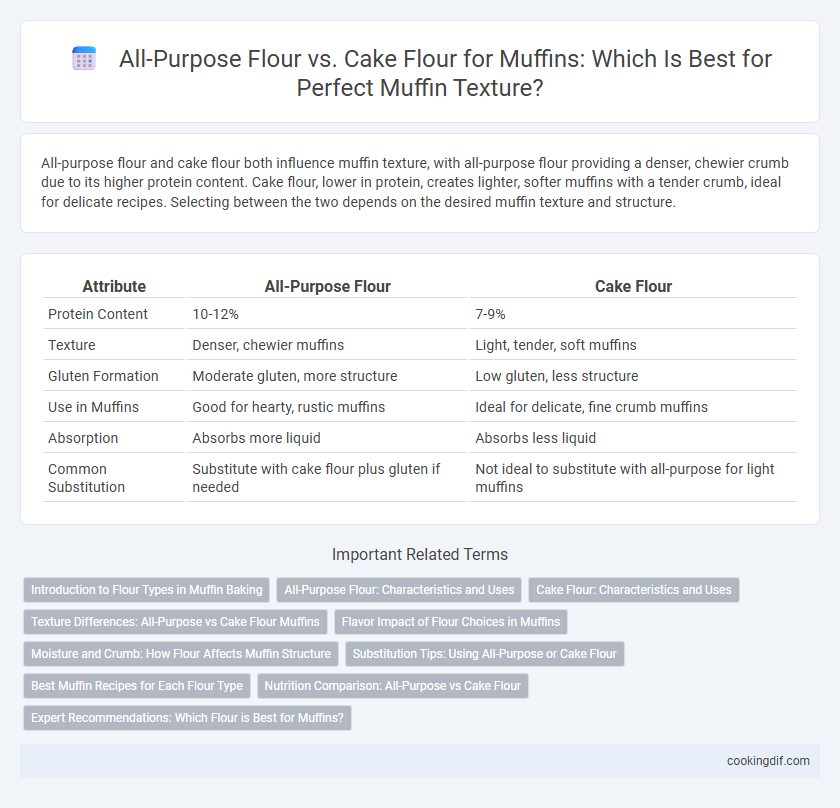All-purpose flour and cake flour both influence muffin texture, with all-purpose flour providing a denser, chewier crumb due to its higher protein content. Cake flour, lower in protein, creates lighter, softer muffins with a tender crumb, ideal for delicate recipes. Selecting between the two depends on the desired muffin texture and structure.
Table of Comparison
| Attribute | All-Purpose Flour | Cake Flour |
|---|---|---|
| Protein Content | 10-12% | 7-9% |
| Texture | Denser, chewier muffins | Light, tender, soft muffins |
| Gluten Formation | Moderate gluten, more structure | Low gluten, less structure |
| Use in Muffins | Good for hearty, rustic muffins | Ideal for delicate, fine crumb muffins |
| Absorption | Absorbs more liquid | Absorbs less liquid |
| Common Substitution | Substitute with cake flour plus gluten if needed | Not ideal to substitute with all-purpose for light muffins |
Introduction to Flour Types in Muffin Baking
All-purpose flour offers a balanced protein content of 10-12%, providing a sturdy structure and slight chewiness ideal for classic muffin textures. Cake flour, with its lower protein level around 7-9% and finer grind, produces a tender, soft crumb that enhances the delicate nature of sweet muffins. Understanding the difference in protein content and texture between all-purpose and cake flour is essential for achieving the desired muffin consistency.
All-Purpose Flour: Characteristics and Uses
All-purpose flour, with its moderate protein content of 10-12%, provides a balanced structure and chewiness ideal for muffins that need a sturdy yet tender crumb. Its versatility allows for good gluten development, resulting in muffins that rise well and hold moisture without excessive density. Using all-purpose flour in muffin recipes ensures a reliable texture and flavor, making it the preferred choice for everyday baking where a slightly denser consistency is desired.
Cake Flour: Characteristics and Uses
Cake flour contains lower protein content, typically around 7-8%, compared to all-purpose flour, resulting in a finer, softer texture ideal for tender muffins. Its finely milled, bleached nature allows for better absorption of liquids and sugar, producing a delicate crumb and lighter rise. Bakers often use cake flour in muffin recipes requiring a moist, airy consistency, enhancing flavor without the density that all-purpose flour may impart.
Texture Differences: All-Purpose vs Cake Flour Muffins
All-purpose flour muffins have a denser and chewier texture due to their higher protein content, which develops more gluten. Cake flour muffins are lighter and softer with a finer crumb because of their lower protein level and finer milling process. Choosing cake flour results in a more tender and delicate muffin, while all-purpose flour provides a heartier and more substantial bite.
Flavor Impact of Flour Choices in Muffins
All-purpose flour and cake flour significantly influence muffin flavor due to their different protein contents; all-purpose flour with higher protein imparts a heartier, slightly nutty taste, while cake flour produces a lighter, more delicate flavor. The choice affects not only texture but also the depth of flavor, with all-purpose flour enhancing the overall robust taste and cake flour emphasizing subtle sweetness. Understanding these differences helps bakers tailor muffin recipes to achieve the desired flavor profile.
Moisture and Crumb: How Flour Affects Muffin Structure
All-purpose flour creates muffins with a denser crumb and slightly chewier texture due to its higher protein content, which promotes gluten development and reduces moisture retention. Cake flour, with lower protein levels, produces lighter, more tender muffins that retain moisture better, resulting in a softer crumb. Selecting cake flour enhances delicate crumb structure and moistness, while all-purpose flour yields sturdier, more resilient muffins.
Substitution Tips: Using All-Purpose or Cake Flour
Using all-purpose flour in muffins provides a denser, chewier texture due to its higher protein content, while cake flour yields a lighter, tender crumb because of its lower protein and finer grind. When substituting cake flour for all-purpose, increase the amount by about 2 tablespoons per cup to maintain structure, or if using all-purpose in place of cake flour, reduce the flour slightly and add a teaspoon of cornstarch per cup to mimic cake flour's softness. Accurate measurement and gentle mixing are crucial to optimize muffin texture regardless of flour substitution.
Best Muffin Recipes for Each Flour Type
All-purpose flour provides muffins with a denser, chewier texture ideal for hearty flavors like banana or blueberry, making it perfect for recipes that benefit from structure and moisture retention. Cake flour, with its lower protein content, produces tender, lighter muffins suited for delicate flavors such as lemon poppy seed or vanilla almond, emphasizing a soft crumb and fine texture. Choosing the right flour based on the desired muffin texture and flavor profile enhances the final baked product, ensuring consistent and delicious results.
Nutrition Comparison: All-Purpose vs Cake Flour
All-purpose flour contains more protein, typically 10-12%, which contributes to higher gluten development and a denser muffin texture, while cake flour has lower protein content around 7-9%, resulting in softer, lighter muffins. Nutritionally, both flours provide similar calorie counts, but all-purpose flour offers slightly more fiber and minerals due to less processing compared to the finely milled, more refined cake flour. Choosing between all-purpose and cake flour impacts muffin texture and nutritional profile, with all-purpose supporting more structure and cake flour yielding tender crumb.
Expert Recommendations: Which Flour is Best for Muffins?
Expert recommendations favor cake flour for muffins due to its lower protein content, which creates a tender crumb and softer texture ideal for moist, fluffy muffins. All-purpose flour, with higher protein levels, can yield denser muffins but provides more structure, making it suitable for heartier recipes. For perfectly balanced muffins, many bakers suggest blending both flours or opting for cake flour when a delicate, tender muffin is desired.
All-purpose flour vs cake flour for muffins Infographic

 cookingdif.com
cookingdif.com